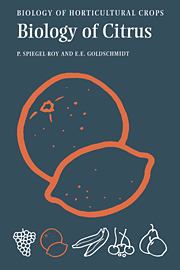3 - The vegetative Citrus tree: development and function
Published online by Cambridge University Press: 27 October 2009
Summary
Introduction
For a comprehensive description of the vegetative Citrus tree it is not enough to provide a structural description of the basic organ units. Attention must also be paid to physiological activity, at the organ level as well as at the whole-plant level. Environmental, eco-physiological aspects of tree activity must also be considered if a broader understanding of citrus tree behavior is to be achieved.
Citrus trees belong to the ‘evergreens’, which do not shed their leaves during the fall. The evergreen habit has important consequences for leaf longevity and physiological activity, which must be reflected in leaf design and structure. In the absence of fall abscission the longevity of leaves may extend to a whole year and beyond. The year-round presence of leaves enables uninterrupted, day-by-day photosynthetic activity, and thus a continuous supply of photosynthates. However, in subtropical climate zones winter temperatures might be quite low so that photosynthetic gains during winter are lowered. The evergreen habit may have significant implications with regard to the role of nutrient reserves, particularly during springtime. Whereas deciduous trees are totally dependent for early spring growth upon their carbohydrate reserves, evergreens like citrus may at least partly rely on the supply of photosynthate from the previous season's foliage. The evergreen character also has far-reaching consequences for the annual cycle of flowering and fruiting, as will be discussed in Chapter 4.
- Type
- Chapter
- Information
- The Biology of Citrus , pp. 47 - 69Publisher: Cambridge University PressPrint publication year: 1996

